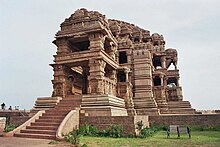Sasbahu Temple, Gwalior

Sas-Bahu ka mandir, or Sahastrabahu Temple, is located to the east of Gwalior Fort. Built in 1092 by King Mahipala of the Kachchhapaghata dynasty, this temple is one of the greatest architectural marvels situated by Gwalior Fort. It is 32 metres long and 22 metres at its breadth. This temple mainly has three entrances from three different directions. In the fourth direction, there is a room which is currently closed. The entire temple is covered with carvings, notably 4 idols of Brahma, Vishnu and Saraswati above its entrance door.However, limestone erodes over time, and soon portions of the limestone fell, later spurring conflict as to whether it was a Jain temple or a Hindu temple. Then, Captain H. Kolar and Major J.B. Kint completely removed the limestone and restored the temple completely.
Etymology
It was named SahastraBahu, depicting Lord Vishnu with a thousand hands . Lord Vishnu was worshiped by the wife of Kachchhapaghata's king, but when his son's wife came, she became a devotee of Lord Shiva. Thus, another temple beside Vishnu temple was built, where Lord Shiva was worshiped by the wife of the king's son. Collectively, these two temples were named 'Sas-Bahu temple', meaning the daughter-in-law and mother-in-law's temple.
External links
 Media related to Sas Bahu Temple, Gwalior at Wikimedia Commons
Media related to Sas Bahu Temple, Gwalior at Wikimedia Commons
